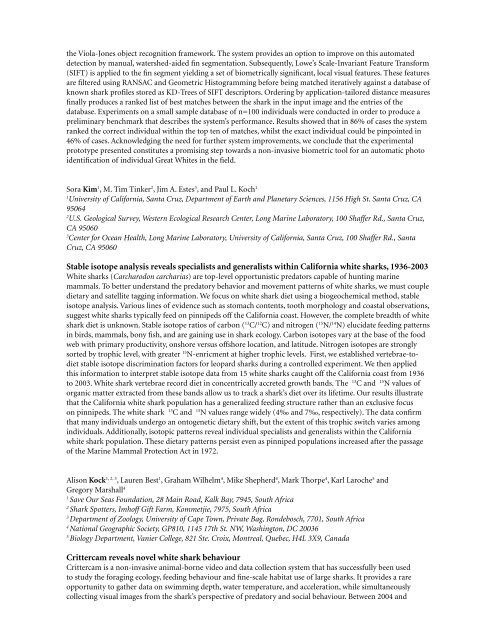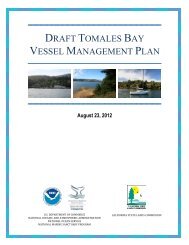Symposium program - Gulf of the Farallones National Marine ...
Symposium program - Gulf of the Farallones National Marine ...
Symposium program - Gulf of the Farallones National Marine ...
Create successful ePaper yourself
Turn your PDF publications into a flip-book with our unique Google optimized e-Paper software.
<strong>the</strong> Viola-Jones object recognition framework. The system provides an option to improve on this automated<br />
detection by manual, watershed-aided fin segmentation. Subsequently, Lowe’s Scale-Invariant Feature Transform<br />
(SIFT) is applied to <strong>the</strong> fin segment yielding a set <strong>of</strong> biometrically significant, local visual features. These features<br />
are filtered using RANSAC and Geometric Histogramming before being matched iteratively against a database <strong>of</strong><br />
known shark pr<strong>of</strong>iles stored as KD-Trees <strong>of</strong> SIFT descriptors. Ordering by application-tailored distance measures<br />
finally produces a ranked list <strong>of</strong> best matches between <strong>the</strong> shark in <strong>the</strong> input image and <strong>the</strong> entries <strong>of</strong> <strong>the</strong><br />
database. Experiments on a small sample database <strong>of</strong> n=100 individuals were conducted in order to produce a<br />
preliminary benchmark that describes <strong>the</strong> system’s performance. Results showed that in 86% <strong>of</strong> cases <strong>the</strong> system<br />
ranked <strong>the</strong> correct individual within <strong>the</strong> top ten <strong>of</strong> matches, whilst <strong>the</strong> exact individual could be pinpointed in<br />
46% <strong>of</strong> cases. Acknowledging <strong>the</strong> need for fur<strong>the</strong>r system improvements, we conclude that <strong>the</strong> experimental<br />
prototype presented constitutes a promising step towards a non-invasive biometric tool for an automatic photo<br />
identification <strong>of</strong> individual Great Whites in <strong>the</strong> field.<br />
Sora Kim 1 , M. Tim Tinker 2 , Jim A. Estes 3 , and Paul L. Koch 1<br />
1<br />
University <strong>of</strong> California, Santa Cruz, Department <strong>of</strong> Earth and Planetary Sciences, 1156 High St. Santa Cruz, CA<br />
95064<br />
2<br />
U.S. Geological Survey, Western Ecological Research Center, Long <strong>Marine</strong> Laboratory, 100 Shaffer Rd., Santa Cruz,<br />
CA 95060<br />
3<br />
Center for Ocean Health, Long <strong>Marine</strong> Laboratory, University <strong>of</strong> California, Santa Cruz, 100 Shaffer Rd., Santa<br />
Cruz, CA 95060<br />
Stable isotope analysis reveals specialists and generalists within California white sharks, 1936-2003<br />
White sharks (Carcharodon carcharias) are top-level opportunistic predators capable <strong>of</strong> hunting marine<br />
mammals. To better understand <strong>the</strong> predatory behavior and movement patterns <strong>of</strong> white sharks, we must couple<br />
dietary and satellite tagging information. We focus on white shark diet using a biogeochemical method, stable<br />
isotope analysis. Various lines <strong>of</strong> evidence such as stomach contents, tooth morphology and coastal observations,<br />
suggest white sharks typically feed on pinnipeds <strong>of</strong>f <strong>the</strong> California coast. However, <strong>the</strong> complete breadth <strong>of</strong> white<br />
shark diet is unknown. Stable isotope ratios <strong>of</strong> carbon ( 13 C/ 12 C) and nitrogen ( 15 N/ 14 N) elucidate feeding patterns<br />
in birds, mammals, bony fish, and are gaining use in shark ecology. Carbon isotopes vary at <strong>the</strong> base <strong>of</strong> <strong>the</strong> food<br />
web with primary productivity, onshore versus <strong>of</strong>fshore location, and latitude. Nitrogen isotopes are strongly<br />
sorted by trophic level, with greater 15 N-enricment at higher trophic levels. First, we established vertebrae-todiet<br />
stable isotope discrimination factors for leopard sharks during a controlled experiment. We <strong>the</strong>n applied<br />
this information to interpret stable isotope data from 15 white sharks caught <strong>of</strong>f <strong>the</strong> California coast from 1936<br />
to 2003. White shark vertebrae record diet in concentrically accreted growth bands. The δ 13 C and δ 15 N values <strong>of</strong><br />
organic matter extracted from <strong>the</strong>se bands allow us to track a shark’s diet over its lifetime. Our results illustrate<br />
that <strong>the</strong> California white shark population has a generalized feeding structure ra<strong>the</strong>r than an exclusive focus<br />
on pinnipeds. The white shark δ 13 C and δ 15 N values range widely (4‰ and 7‰, respectively). The data confirm<br />
that many individuals undergo an ontogenetic dietary shift, but <strong>the</strong> extent <strong>of</strong> this trophic switch varies among<br />
individuals. Additionally, isotopic patterns reveal individual specialists and generalists within <strong>the</strong> California<br />
white shark population. These dietary patterns persist even as pinniped populations increased after <strong>the</strong> passage<br />
<strong>of</strong> <strong>the</strong> <strong>Marine</strong> Mammal Protection Act in 1972.<br />
Alison Kock 1, 2, 3 , Lauren Best 1 , Graham Wilhelm 4 , Mike Shepherd 4 , Mark Thorpe 4 , Karl Laroche 5 and<br />
Gregory Marshall 4<br />
1<br />
Save Our Seas Foundation, 28 Main Road, Kalk Bay, 7945, South Africa<br />
2<br />
Shark Spotters, Imh<strong>of</strong>f Gift Farm, Kommetjie, 7975, South Africa<br />
3<br />
Department <strong>of</strong> Zoology, University <strong>of</strong> Cape Town, Private Bag, Rondebosch, 7701, South Africa<br />
4<br />
<strong>National</strong> Geographic Society, GP810, 1145 17th St. NW, Washington, DC 20036<br />
5<br />
Biology Department, Vanier College, 821 Ste. Croix, Montreal, Quebec, H4L 3X9, Canada<br />
Crittercam reveals novel white shark behaviour<br />
Crittercam is a non-invasive animal-borne video and data collection system that has successfully been used<br />
to study <strong>the</strong> foraging ecology, feeding behaviour and fine-scale habitat use <strong>of</strong> large sharks. It provides a rare<br />
opportunity to ga<strong>the</strong>r data on swimming depth, water temperature, and acceleration, while simultaneously<br />
collecting visual images from <strong>the</strong> shark’s perspective <strong>of</strong> predatory and social behaviour. Between 2004 and







